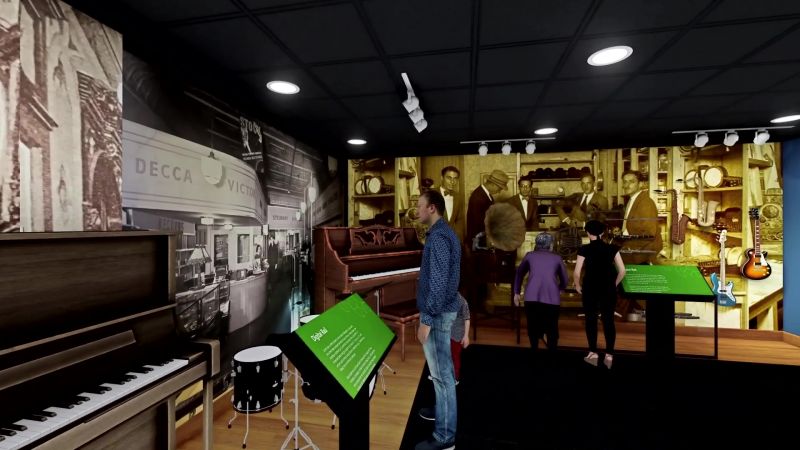Museum of Making Music Gallery Two Preview

NAMM’s Museum of Making Music is undergoing its largest renovation since it opened its doors in 1998. The transformation is currently underway, with the grand reopening scheduled for 2021.
After you’ve experienced the first gallery: “Making the Instruments,” (The gallery preview can reviewed at /playback/advancing-music-making/museum-making-music-gallery-one-%E2%80%9Cmaking) visitors will make their way into the second gallery: “Providing the Instruments.” This gallery tells the story of how we gain access to, and connect with, musical instruments. This narrative, unique to the Museum of Making Music, is a multifaceted story of retailing, marketing, and entrepreneurship. While the previous gallery is organized by instrument groupings, the “Providing the Instruments” story is presented chronologically with topics including economic changes, shifts in popular culture, and pivotal historical moments impacting the industry. The purpose of the second gallery is to provide visitors with awareness, appreciation, and understanding of how instruments enter and travel through the marketplace and into our hands.

“Providing the Instruments” is separated into five main thematic displays, each of which are illustrated by era-appropriate instruments and products, as well as a touch screen that allows visitors to explore the gallery’s stories, oral histories, music clips, and images. Also included is an area to sit and play, equipped with hands-on vintage and contemporary instruments and an educational Science, Technology, Engineering, and Mathematics (STEAM) station which explores the concept of entrepreneurship as well as innovation and creativity in today’s globally connected world – all from the perspective of music. Questions addressed in the STEAM station include, “How is STEAM used in launching and running a company that provides musical instruments or instruction to the world?” and “What are some of the many ways someone can have a career in the music products industry?”
Birth and Boom (1900s to 1920s): New industrialization techniques, along with an expanding population driven by migration from Europe, and a faster and broader transportation network, led to a middle class eager for leisure goods. Instrument makers had increased access to a growing labor pool and expanding sources of capital, and piano makers led the way as mechanization, and interchangeable parts helped lower prices. As a result, the music products industry emerged in the United States at the turn of the 20th century. Included in this theme are the concepts of “The Rise of the One Stop Shop,” “Instruments on your Doorstep,” and “Earning the Public’s Trust.”
Crisis and Creativity (1930s to 1940s): As The Great Depression crippled the U.S. and world economies, the glory days of mass consumption of the decade earlier was long gone. However, by the end of the 1930s, the economy was largely recovered and as the U.S. entered into World War II there was a dramatic shift in economic activity as most industries refocused on supporting the war effort. Musical products were no exception and factories retooled to produce components for military operations, while retailers found creative ways to stay afloat. Subthemes within “Crisis and Creativity” include “New Won’t Sell,” “We’ll Try Anything,” and “Electric Shocks.”
Searching for Stability (1950s to 1960s): The period following WWII was wrought with its challenges for the industry, including government-imposed pricing restrictions and the continuation of materials shortages. Despite these hurdles, a rising birth rate, the shift to suburban living, the popularity of television, and a vibrant manufacturing sector helped drive a consumer culture that demanded new and improved products. These factors, combined with the advent of rock and roll and its impact on popular culture, cemented the viability of the music products industry for decades. Visitors will see displays including, “Urban and Suburban,” “A New Generation,” and “Rock and Roll Tops the Charts.”
Bigger, Faster, Louder: The increased government spending and reduced taxation of the 1960s created a thriving economy, but the bubble did not last as the cost of social programs outpaced revenue and the Vietnam War increased in scope and economic impact. As a result, inflation was on the rise, which led to an influx of foreign goods and unprecedented interest rates. All was not dismal however, with the appearance of the Beatles on The Ed Sullivan Show, there was a massive uptick in guitar, drum, bass, and amplifier sales. Spotlight themes within “Bigger, Faster, Louder” include “The Beatles Boom,” “Malls, Combos, and Big Boxes,” and “New Instruments, New Connections.”
Diving Into the Digital Deep: Throughout the 1990s, the landscape of the music products industry experienced massive changes. Global events such as the end of the Cold War, the ongoing savings and loan crisis, the Gulf War, contributed to a decade-long economic boom. Other factors influencing the industry include the development of the Internet into popular consciousness which led to the world of digital commerce and increased consumption of music. The innovation led to new styles of music which in turn drove the need for new instruments, gear, and new retail techniques. The dot com bubble, and its inevitable burst, contributed to a recession in the early 2000s. However, the economy recovered quickly until the Great Recession of 2007. Unemployment, reductions in household wealth, and a lack of credit were regular struggles until the mid-2010s, when economic recovery began. However, progress in some industry segments was largely undone with the onset of the COVID-19 pandemic and subsequent economic recession. Despite the economic impact of the Coronavirus, unprecedented adaptation of Internet technologies for making music took place. Within this portion of the gallery themes such as “From Status Quo to a New Reality,” “Brick and Mortar Music,” and “Any Music, Anytime, Anywhere” can be experienced.
The Museum of Making Music’s entire renovation plan can be viewed at https://www.museumofmakingmusic.org/renovation.